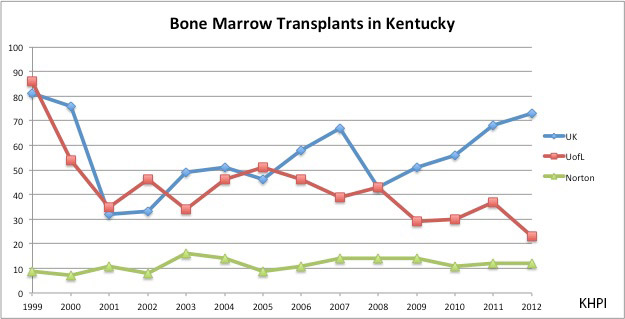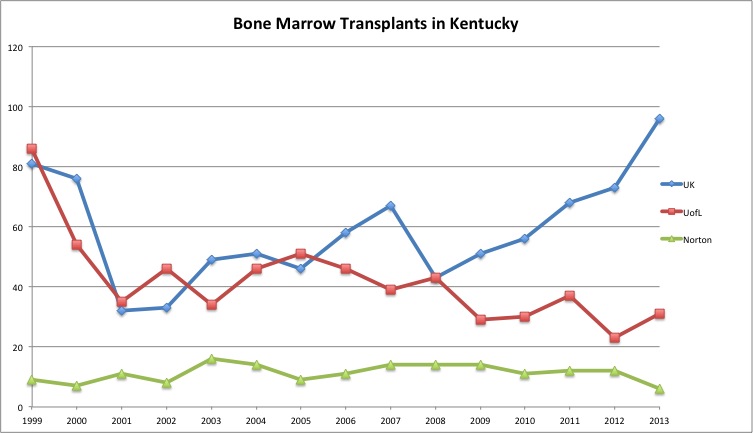 For the 30 years in which I have been associated with the University of Louisville, it’s bone marrow transplantation program has been a feather in its cap and that of the James G. Brown Cancer Center. The University of Louisville Hospital holds the Certificate of Need (CON) for adult bone marrow transplantation in Louisville – one of the tiny handful of programs that other local hospitals could not take away or did not want. Therefore I was concerned when I began to hear of doctors-lounge gossip that the program was going through a difficult patch. Unfortunately, a review of publicly available information validates my concern.
For the 30 years in which I have been associated with the University of Louisville, it’s bone marrow transplantation program has been a feather in its cap and that of the James G. Brown Cancer Center. The University of Louisville Hospital holds the Certificate of Need (CON) for adult bone marrow transplantation in Louisville – one of the tiny handful of programs that other local hospitals could not take away or did not want. Therefore I was concerned when I began to hear of doctors-lounge gossip that the program was going through a difficult patch. Unfortunately, a review of publicly available information validates my concern.
Loss of UofL’s Program Director
Last month, Dr. Roger Herzig, the respected and long-serving senior Director of U of L’s bone marrow/stem cell transplantation program, left to lead the same program at the University of Kentucky. He was not the first senior faculty member from the Brown Cancer Center to switch allegiance to Kentucky’s only National Cancer Institute Comprehensive Cancer Center. At present, only one physician is listed on the Brown Cancer Center’s website as being active in bone marrow transplantation. That person is a relatively junior faculty member. Bone marrow and stem cell transplantation centers are accredited by the Foundation for the Accreditation of Cellular Therapy (FACT) whose standards require a minimum of two experienced physicians. I have no knowledge of how UofL and KentuckyOne will approach the staffing needs.
Decreasing patient volumes.
Worrisome also is what appears to be a drop in the number of procedures from 37 in calendar year 2011, to 23 in the 2012- the most recent year for which a Kentucky Annual Hospital Utilization and Services Report is available. A downward trend in past years is evident. While only 10 procedures per year are required to maintain FACT accreditation, a major change in leadership and staffing must be reported and automatically triggers a possible reaccreditation site-visit.
Threat to Louisville’s pediatric transplant program?
Norton’s Kosair Childrens Hospital holds the CON for pediatric bone marrow transplantation in Louisville– indeed it is the only approved pediatric program in Kentucky. In 2012, it reported having done a rather stable 12 procedures. However, Norton-Kosair holds its FACT accreditation jointly with the program at University Hospital. Who would have guessed! Indeed, a hematologist/oncologist from UofL’s Department of Pediatrics is now listed by FACT as the director of the entire UofL bone marrow program. UofL’s program currently is listed along with other accredited programs.
FACT accreditation criteria state that:
“only those programs that truly function as a single integrated program may apply as one Clinical Program. … This standard means that clinicians accredited together as a Clinical Program must work together in readily demonstrable ways on a daily basis, and have a single director or codirectors (the Program Director(s)), each of whom is responsible for these clinical transplant activities. Programs that include non-contiguous sites must be sites within the same defined network.”
Working Hand-in Hand?
I believe that a site-visitor coming to Louisville would perceive three organizations vigorously tearing themselves asunder both in and out of the courtroom. It would take a great deal of public-relations-spin indeed to convince even a superficial observer that everything is hunky-dory, or that the University of Louisville, KentuckyOne Health (which manages the Brown Cancer Center), and Norton Healthcare (that manages Kosair Children’s Hospital) are playing well together let alone providing sophisticated and coordinated healthcare “within the same defined network.” Clearly any problems that the Brown Cancer Center’s transplant program might be having will adversely affect the program at Children’s Hospital.
A new transplant player in town.
As UofL began to withdraw its affection from Norton, the University of Kentucky came a-courtin’. In June 2011, UK and Norton announced a partnership that includes a “cancer program that will share resources, research agendas and clinical trials” as well as a joint transplant clinic that serves to refer patients to Lexington for both solid-organ and bone marrow transplants and to provide followup outpatient care afterwards. In 2012, UK performed 165 solid organ transplants against 145 at Jewish Hospital, and 73 bone marrow procedures compared to the 23 at UofL. This unfortunate and arguably unnecessary competition may be partly responsible for the decline in transplants at University Hospital.
Who should be transplanting and where?
I tallied up the number of solid organ and marrow transplants reported in Kentucky over the last 14 years and will present that data next week when the data from 2013 becomes available. I was frankly surprised to see that UK did not report a single pediatric bone marrow transplant! UK has an active pediatric Hematology and Oncology program in which bone marrow transplantation is recommended when indicated. However, it is my understanding that children requiring these services are referred to Children’s Hospital in Cincinnati which performs over 100 pediatric marrow procedures yearly. The question thus asks itself, “at what patient volume threshold is it justified both financially and clinically to offer transplantation services. How many is too few to justify the enormous cost or to maintain the high level of ultra-sophisticated coordinated care for some of the sickest patients to cross a care-giver’s threshold? Both Kentucky Children’s Hospital and Norton’s Kosair reported performing only a small handful of solid-organ transplants over the years. Is one case every 4 to 6 months enough? Probably not. If there was ever an example of why broader integration and cooperation between providers is necessary this is it. Unfortunately we are moving in the opposite direction of bunker building and medically unjustified expensive competition. Transplant programs should not become vulnerable just because a single key player retires or leaves. Even an assumption that fewer than one complex procedure a month is adequate to keep a team well oiled and sharp leaves me baffled.
UofL its own worst enemy?
No doubt we will be hearing more about these matters in the weeks to come. But there should be absolutely no doubt in anyone’s mind that the current contentious medical environment within and surrounding our academic medical center will completely reshape the medical infrastructure of Lousiville. I have no confidence that this will be for the better. Readers of this series will not be surprised when I restate my opinion that the long-standing diversion of clinical revenues from University Hospital and its faculty to feed the non-clinical demands of the University of Louisville, and the more recent use of University Hospital profits to shore up a financially stressed KentuckyOne Health system have been disruptively harmful to what should be Louisville’s premier hospital, and is therefore also harmful to our community. In my opinion, the ongoing withdrawal of resources and priority from the clinical and educatonal operations of the medical school have demonstably weakened both. I find it ironic that our University, which has pressed its commercial research agenda above all else (save perhaps its athletic and real-estate aspirations) has bragged long and often about its prowess in bone marrow transplantation research! The argument that success in sports or research will carry over to the core responsibilities of teaching and clinical service at our University medical center have yet to be demonstrated.
As always, if I have made an error in fact, please call that to my attention. If you have another interpretation, please share it with us.
Peter Hasselbacher, MD
President, KHPI
Emeritus Professor of Medicine, UofL
August 29, 2014
[Addendum, 9-9-14: I erroneously overstated the total number of solid-organ transplantations at UK in 2012. The corrected number entered above is 165, not 238. Big difference! PH]
[Addendum Oct 13, 2014: After this article was written, the BMT numbers for 2013 as reported to the state became available and are incorporated into the chart below. In 2013, the number of BMTs performed at UK (blue) rose sharply. These were all adult patients as pediatric cases from UK are usually sent to Cincinnati. The number of adult cases done at UofL Hospital (red) rose slightly. The number of pediatric cases at Norton Kosair Children’s Hospital (green) continues to decline. All the points made in the article above remain valid.]


